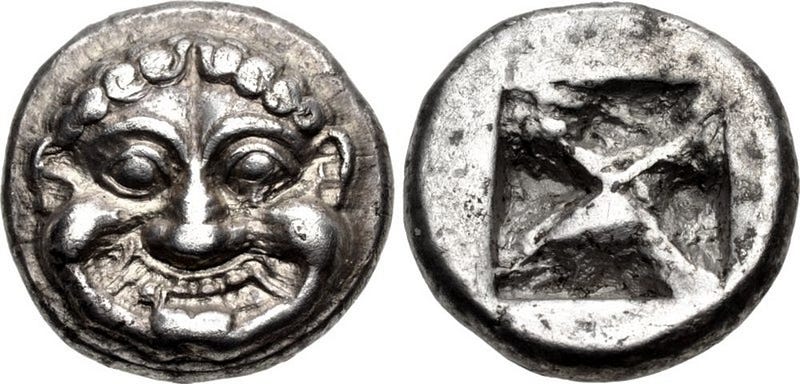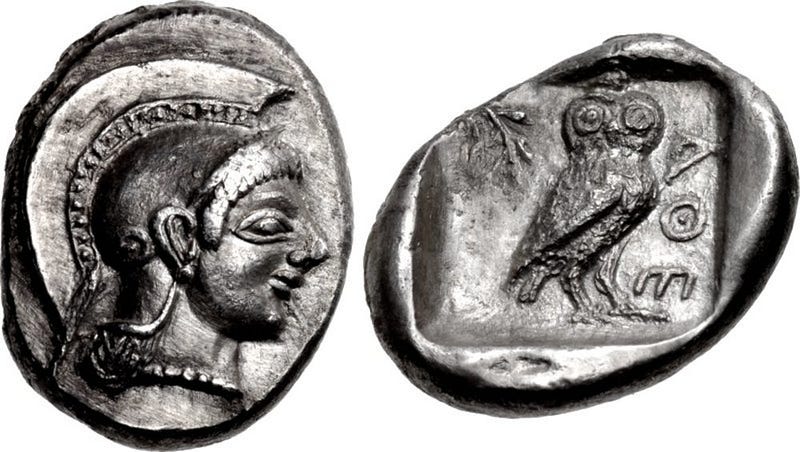Exploring Ancient Greek Banking Practices and Their Impact
Written on
Chapter 1: The Role of Banks in Ancient Greece
Let’s delve into the functionality of banks during ancient Greece.

The initial coinage of Athens dates back to 545–525 BC. During the 5th century BC, bankers were often seen as more unscrupulous than today's loan sharks. The public perception was such that loans were associated with a lack of friendship; as the adage goes, “where a loan exists, friendship does not,” implying that true friends do not lend money but rather give it freely.
Interest on loans was perceived merely as a hollow token of gratitude from the borrower to the lender. In his work, Laws, Plato advocated for the prohibition of interest-bearing loans. The focus of ancient Greek society was not on wealth but rather on human relationships. Philosophers viewed money as a tool for acquiring goods, rather than an end in itself. This philosophical stance led to the perception that moneylending, particularly with interest, was unethical.
The practice of charging interest faced criticism from various Greek and foreign thinkers, including Aristotle, Plutarch, Cicero, and even Muhammad. When Roman senator Cato was queried about his views on interest-bearing loans, he famously equated them to murder.
Ancient Greece was composed of numerous city-states, each minting its own currency, leading to a wide variance in real and nominal values. This multitude of currencies complicated trade, resulting in the emergence of an early form of a foreign exchange market.
At the heart of this market were the 'money changers' (literally, ‘paid in silver’). Their role was to facilitate the exchange of coins for a fee, necessitating a thorough understanding of the value and weight of various coins. They were trained to identify counterfeit and worn coins.
However, the Greeks were not inclined to engage in forex trading as we do today; their currency exchange operations were limited to money handlers. In essence, money remained a means to achieve other goals rather than a commodity for trade.
Private bankers began to expand their operations into this nascent forex market as well. Occasionally, coins were melted down for their metal value, particularly in areas lacking these resources, as it was often more cost-effective than sourcing raw metal.
Bankers also capitalized on cash-strapped regions by trading coins for land or other valuable properties, later reselling them for profit. This practice might ring a bell for those familiar with modern financial systems.

To summarize, the primary functions of banks in ancient Greece included:
- Coin testing and exchange
- Deposits
- Loans
- Money orders for third parties
As time progressed, bankers began to diversify their activities. These included:
- Management of various assets, including estates
- Loan agreements and consignments
- Letters of credit, serving as a precursor to inter-bank credit across city-states
Cicero reportedly used letters of credit to fund his son's expenses while in Athens. The fees for money changers ranged from 5% to 6% for coins of the same material, often higher for those made of different metals.
'Sacred banks' provided safe storage for valuables without charging fees or paying interest on short-term deposits. Long-term deposits in Athens during the 4th century BC yielded approximately 10% interest. Temples and other sacred sites also acted as banks, competing with private institutions. However, the interest rates from private banks far exceeded those of sacred banks.
Interest rates for 'sail loans' could soar to 100%, reflecting the high-risk nature of maritime ventures, where shipwrecks could result in total loss for the owners—akin to modern high-risk bonds.
As private banks amassed wealth, they began to cater to the financial needs of entire city-states. However, during peacetime, city-states rarely sought loans, prioritizing infrastructure and savings for future needs, which led to diminished business for banks.
The profitability of banks fluctuated significantly—revenue dropped during peaceful times but surged in wartime, incentivizing banks to leverage their influence to instigate conflicts. They could sway the outcomes of wars by selectively funding city-states, reminiscent of the practices depicted in Game of Thrones with the Iron Bank of Braavos.
Through their financial control, bankers shaped the financial, social, and political landscape of ancient Greece. This influence is reflected in ancient art, which often illustrated the plight of individuals ruined by debts to bankers. While ancient Greece thrived in trade, culture, and military prowess, its role in the financial realm was limited, largely due to prevalent views against interest-bearing loans. Consequently, the gap was often filled by dubious and ethically questionable bankers.
Chapter 2: The Evolution of Banking Practices
This video titled "Silver & Credit Money in Ancient Athens | History of Money" explores the intricacies of currency and credit in ancient Athenian society, shedding light on how these practices influenced their economy.
The second video, "Money-changing and Banking in Ancient Greece and Rome," provides an in-depth examination of the banking systems in these ancient civilizations, highlighting their similarities and differences.
Sources:
- The Private Banks in Fourth-Century B. C. Athens: A Reappraisal | JSTOR
- Debt in Ancient Athens and Solon’s Reforms | Harvard
- The origins of money in Ancient Greece: the political economy of coinage and exchange | JSTOR
- Plato on Utopia | Stanford Encyclopedia of Philosophy
This article was meticulously crafted by Nikolaos Skordilis, who also examined contemporary economic themes such as inflation and stagflation.